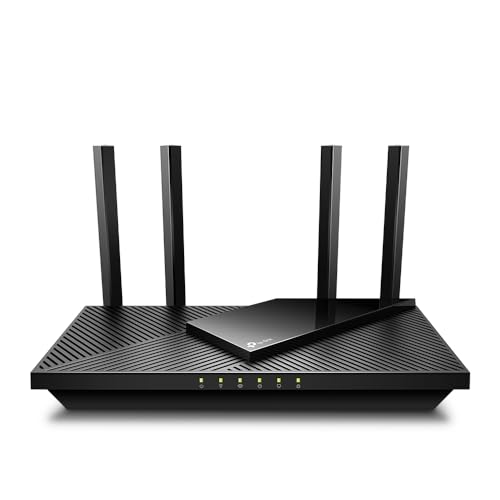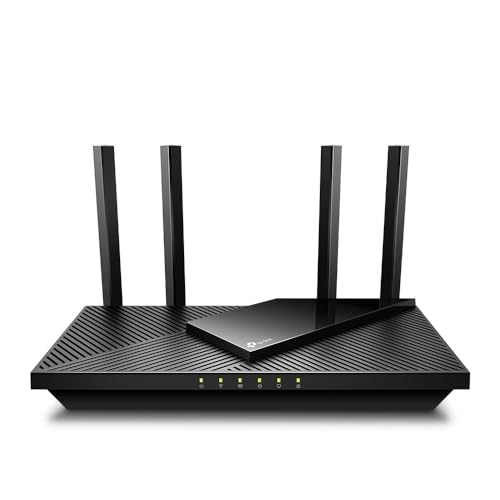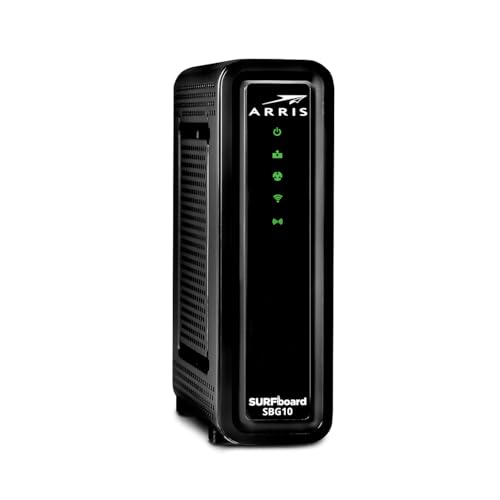Tired of buffering videos, lagging online games, and dead zones in your home? In today’s hyper-connected world, a slow, unreliable internet connection can be incredibly frustrating. With more devices than ever clamoring for bandwidth – from your smart TV streaming 4K content to your kids gaming online and your smart home gadgets all chattering away – a standard router just won’t cut it anymore. What you need is a powerful upgrade: the best high speed WiFi router for home.
Investing in a top-tier router can transform your entire online experience, offering faster speeds, wider coverage, and a more stable connection for every corner of your house. But with so many options on the market, how do you choose? We’ve done the heavy lifting for you, breaking down some of the leading contenders that promise to deliver a blazing-fast and reliable wireless network.
Ready to kick your old router to the curb and embrace the future of connectivity? Let’s dive into our top picks!
What Makes a WiFi Router “High Speed”?
Before we jump into the reviews, let’s quickly clarify what makes a router truly high-speed, especially for a home environment.
- WiFi 6 (802.11ax) & WiFi 6E (802.11axe): These are the latest wireless standards, offering significantly faster speeds, lower latency, and better efficiency, especially when many devices are connected. WiFi 6E adds a brand-new 6 GHz band, which is less congested and offers even higher speeds.
- Dual-Band or Tri-Band: Dual-band routers use 2.4 GHz and 5 GHz frequencies. Tri-band adds a second 5 GHz band or the new 6 GHz band (for WiFi 6E), dedicating more pathways for data and reducing congestion.
- High Aggregate Speeds (e.g., AX1800, AX5400, AXE5400): These numbers refer to the theoretical maximum combined speed across all bands. Higher numbers generally mean more bandwidth available for your devices.
- Gigabit Ethernet Ports: For devices that benefit from a wired connection (like gaming consoles, PCs, or smart TVs), Gigabit (1000 Mbps) Ethernet ports ensure you get the fastest possible speed directly from the router.
- Advanced Technologies: Features like OFDMA (Orthogonal Frequency-Division Multiple Access) and MU-MIMO (Multi-User, Multiple-Input, Multiple-Output) allow the router to communicate with multiple devices simultaneously, improving efficiency. Beamforming focuses the signal directly to your devices, enhancing range and stability.
Understanding these features will help you pick the best high speed WiFi router for home that fits your specific needs and budget.
Our Top 5 Best High Speed WiFi Routers for Home
Here are our hand-picked selections for the top high-speed WiFi routers that will elevate your home internet experience.
1. TP-Link AX1800 WiFi 6 Router V4 (Archer AX21)

The TP-Link Archer AX21 V4 is an excellent entry point into the world of WiFi 6, offering a significant upgrade for most homes without breaking the bank. This router stands out with its robust VPN server support (both OpenVPN and PPTP), allowing you to secure your network and access content from anywhere. It delivers a solid 1.8 Gbps of total bandwidth, perfect for smooth streaming, gaming, and everyday browsing across multiple devices, making it a fantastic contender for the best high speed WiFi router for home on a budget.
- Key Features
- VPN SERVER: Supports both OpenVPN Server and PPTP VPN Server.
- DUAL-BAND WIFI 6 ROUTER: Wi-Fi 6 (802.11ax) technology for faster speeds and greater capacity.
- AX1800: Up to 1.8 Gbps total bandwidth (1200 Mbps on 5 GHz, 574 Mbps on 2.4 GHz).
- CONNECT MORE DEVICES: OFDMA technology allows simultaneous data transmission to more devices.
- EXTENSIVE COVERAGE: Beamforming, 4 high-gain antennas, and an advanced FEM chipset enhance WiFi range.
- WORKS WITH ALL INTERNET SERVICE PROVIDERS.
- Pros
- Affordable entry into WiFi 6.
- Built-in VPN server offers great flexibility and security.
- Good coverage for small to medium-sized homes.
- Easy setup via the TP-Link Tether app.
- Reliable performance for everyday tasks and casual gaming.
- Cons
- Not ideal for extremely large homes or very demanding 8K streaming.
- Only AX1800 speed, which might be a bottleneck for ultra-high-speed internet plans (1 Gbps+).
- Lacks advanced features like USB sharing or advanced parental controls found in higher-end models.
- User Impressions
Customers frequently praise the Archer AX21 for its straightforward setup and noticeable improvement over older WiFi 5 routers. Many appreciate its stable connection and the added security benefit of the VPN server. It’s often highlighted as a great value proposition for those looking to upgrade to WiFi 6 without spending a fortune.
2. TP-Link AX5400 WiFi 6 Router (Archer AX73)

If you’re looking for serious horsepower for your home network, the TP-Link Archer AX73 is a formidable choice. This router takes things up a notch with a blazing AX5400 speed rating, making it ideal for homes with multiple 8K streaming devices, intense online gaming, and a multitude of connected smart devices. Its focus on extensive coverage with 6 antennas and advanced technologies ensures that even large homes get stable, high-speed WiFi, solidifying its place as a top contender for the best high speed WiFi router for home where performance is paramount. Plus, the premium HomeShield security services add peace of mind.
- Key Features
- Gigabit WiFi for 8K Streaming: Up to 5400 Mbps WiFi for demanding activities.
- Full Featured WiFi 6 Router: 4T4R and HE160 technologies on the 5 GHz band for max 4.8 Gbps connections.
- Connect More Devices: Supports MU-MIMO and OFDMA for reduced congestion and 4X average throughput.
- Extensive Coverage: High-Power FEM, 6× Antennas, Beamforming, and 4T4R structures for wide, stable WiFi.
- More Vents, Less Heat: Improved ventilation design for optimal performance.
- USB Sharing: 1× USB 3.0 port for easy media sharing and private cloud storage.
- TP-Link HomeShield: Premium network security and IoT protection (free basic features, Pro subscription available).
- Works with all internet service providers.
- Pros
- Excellent speed for 8K streaming and high-bandwidth applications.
- Superior coverage for larger homes.
- USB 3.0 port for network storage and media sharing.
- Advanced network security with TP-Link HomeShield.
- Efficient heat dissipation ensures consistent performance.
- Cons
- HomeShield Pro features require a paid subscription after trial.
- Higher price point than entry-level WiFi 6 routers.
- May be overkill for smaller homes with basic internet needs.
- User Impressions
Users consistently report significant speed and coverage improvements after upgrading to the AX73. Gamers and streamers particularly appreciate the low latency and stable connections. The inclusion of a USB port for network storage is a common highlight, as is the effective range that eliminates many dead zones.
3. TP-Link AXE5400 Tri-Band WiFi 6E Router (Archer AXE75)

Step into the future of wireless connectivity with the TP-Link Archer AXE75. This router isn’t just fast; it’s a Tri-Band WiFi 6E powerhouse, adding the revolutionary 6 GHz band to the mix. This new band acts like a superhighway, completely free from interference from older devices, delivering unprecedented speeds and near-zero latency for the most demanding applications like responsive gaming and crystal-clear video calls. With a powerful 1.7 GHz Quad-Core CPU and 512 MB of high-speed memory, this router is built to handle anything you throw at it, truly defining what makes the best high speed WiFi router for home in the next generation.
- Key Features
- Tri-Band WiFi 6E Router: Up to 5400 Mbps (2402 Mbps on 6 GHz, 2402 Mbps on 5 GHz, 574 Mbps on 2.4 GHz).
- WiFi 6E Unleashed: Brand new 6 GHz band for more bandwidth, faster speeds, and near-zero latency.
- Connect More Devices: True Tri-Band and OFDMA technology increase capacity by 4 times.
- More RAM, Better Processing: Armed with a 1.7 GHz Quad-Core CPU and 512 MB High-Speed Memory.
- OneMesh Supported: Creates a seamless whole-home mesh network with TP-Link OneMesh Extenders.
- VPN Server and Client: Supports both VPN Server and VPN Client (OpenVPN/PPTP/L2TP).
- TP-Link HomeShield: Premium security service with basic free features.
- Works with all internet service providers.
- Pros
- Future-proof with WiFi 6E technology and the uncongested 6 GHz band.
- Exceptional speeds and ultra-low latency, especially on the 6 GHz band.
- Powerful CPU and ample RAM for handling heavy network traffic.
- OneMesh support for easy whole-home WiFi expansion.
- Versatile VPN Server/Client functionality.
- Cons
- Requires WiFi 6E compatible devices to fully utilize the 6 GHz band.
- Higher cost due to cutting-edge technology.
- Many users might not yet have devices that can take advantage of the 6 GHz band.
- User Impressions
Early adopters of the Archer AXE75 rave about the incredible speeds and stability, especially on the 6 GHz band when paired with compatible devices. The powerful processor ensures smooth operation even under heavy load. Users also appreciate the integrated VPN capabilities and the option to expand with OneMesh for larger homes.
4. NETGEAR 4-Stream WiFi 6 Router (R6700AX)

The NETGEAR R6700AX offers a compelling blend of speed, coverage, and renowned NETGEAR reliability. This 4-stream WiFi 6 router brings AX1800 Gigabit speeds to your home, ensuring uninterrupted streaming, HD video gaming, and seamless web conferencing for up to 20 devices across 1,500 sq. ft. It’s a fantastic choice for those looking for a dependable upgrade to WiFi 6 from a trusted brand, delivering solid performance that makes it a strong contender for the best high speed WiFi router for home that prioritizes value and brand reputation.
- Key Features
- Coverage up to 1,500 sq. ft. for up to 20 devices.
- Fast AX1800 Gigabit speed with WiFi 6 technology.
- Built-in security measures and enhanced safety features.
- Compatible with any internet service provider up to 1 Gbps.
- 4 x 1 Gig Ethernet ports for wired devices.
- Pros
- Reliable WiFi 6 performance from a well-established brand.
- Good coverage for average-sized homes.
- Strong emphasis on built-in security features.
- Ample Gigabit Ethernet ports for wired connections.
- Easy to set up and manage.
- Cons
- AX1800 speed might not fully satisfy users with multi-gig internet plans.
- Lacks advanced features like USB ports or multi-gig Ethernet.
- Might not offer sufficient coverage for very large or multi-story homes.
- User Impressions
Customers often highlight the R6700AX’s ease of installation and the immediate improvement in WiFi speed and stability compared to older routers. NETGEAR’s reputation for reliable hardware is frequently mentioned, and users appreciate the consistent performance for everyday tasks, streaming, and online gaming.
5. NETGEAR Nighthawk 6-Stream Dual-Band WiFi 6 Router (RAX54S)

For those who demand top-tier performance and robust security, the NETGEAR Nighthawk RAX54S is an excellent investment. This 6-stream AX5400 WiFi 6 router is built to handle the busiest home networks, providing extensive coverage up to 2,500 sq. ft. for up to 25 devices. What truly sets it apart is NETGEAR Armor, offering a comprehensive shield of security for all your connected devices, including a 1-year subscription. Coupled with the intuitive Nighthawk app, it’s a powerhouse that makes a compelling case for the best high speed WiFi router for home users focused on both performance and peace of mind.
- Key Features
- Coverage up to 2,500 sq. ft. for up to 25 devices.
- Fast AX5400 Gigabit speed with WiFi 6 technology.
- NETGEAR Armor provides an automatic shield of security (1-year subscription included).
- Connects to your existing cable modem, compatible with any ISP up to 1Gbps.
- 4 x 1 Gig Ethernet ports and 1 USB 3.0 port.
- Easily set up and manage your WiFi with the Nighthawk app.
- Pros
- Outstanding speed and coverage for large homes and numerous devices.
- Integrated NETGEAR Armor offers excellent network security and privacy.
- USB 3.0 port for network storage and media sharing.
- User-friendly Nighthawk app for easy management.
- Strong performance for demanding applications like HD streaming and gaming.
- Cons
- NETGEAR Armor becomes a paid subscription after the first year.
- Higher price point, which might be overkill for smaller homes.
- Can be a bit bulky in design for some aesthetics.
- User Impressions
The RAX54S receives high marks for its powerful performance and wide coverage, effectively eliminating dead zones even in larger homes. Users particularly value the added layer of security provided by NETGEAR Armor and the convenience of managing settings via the Nighthawk app. The stability and speed for gaming and 4K streaming are frequently praised.
Conclusion
Choosing the best high speed WiFi router for home depends heavily on your specific needs, home size, and budget. Whether you’re a casual internet user looking for a reliable upgrade or a power user demanding the absolute fastest speeds for 8K streaming and competitive gaming, there’s a perfect router out there for you.
For those on a budget seeking a solid WiFi 6 entry, the TP-Link Archer AX21 V4 is an excellent choice. If you’re tackling a larger home with lots of devices and demanding media, the TP-Link Archer AX73 or the NETGEAR Nighthawk RAX54S offer a fantastic blend of speed, coverage, and advanced features. And if you’re ready to future-proof your network with the latest and greatest, the TP-Link Archer AXE75 with its WiFi 6E capabilities is a true game-changer.
No matter which you choose, upgrading to a high-speed WiFi 6 or 6E router will undoubtedly enhance your entire online experience, providing the reliable and blazing-fast connectivity your modern home deserves. Say goodbye to frustrating lag and hello to seamless surfing!
FAQ Section
Q1: What’s the biggest difference between WiFi 5 and WiFi 6?
A: WiFi 6 (802.11ax) offers significantly faster theoretical speeds, but its main advantage for home users is improved efficiency. It’s better at handling multiple devices simultaneously, reducing latency, and enhancing performance in congested network environments compared to WiFi 5 (802.11ac).
Q2: Do I need a WiFi 6E router?
A: WiFi 6E is ideal for early adopters and power users with the latest devices that support the 6 GHz band. This band is completely uncongested, offering incredibly fast speeds and ultra-low latency. If you have a lot of new WiFi 6E compatible devices (like newer smartphones, laptops, or VR headsets) and a multi-gigabit internet plan, it’s a fantastic future-proof investment. Otherwise, a good WiFi 6 router is more than sufficient for most homes.
Q3: What does AX1800 or AX5400 mean?
A: These numbers represent the theoretical maximum aggregate speed of the router across all its frequency bands (2.4 GHz, 5 GHz, and 6 GHz if applicable). For example, AX1800 might combine 574 Mbps on 2.4 GHz and 1200 Mbps on 5 GHz. Higher numbers indicate more overall bandwidth available.
Q4: Will a new router make my internet speed faster?
A: A new, high-speed router can only deliver speeds up to the maximum provided by your internet service provider (ISP). However, it can significantly improve the effective speed and reliability of your WiFi network by reducing bottlenecks, extending coverage, and efficiently managing multiple connected devices. So, while it won’t magically give you a faster internet plan, it will ensure you’re getting the most out of the speed you pay for.
Q5: What is a “dead zone” and how can a good router help?
A: A “dead zone” is an area in your home where your WiFi signal is weak or non-existent. This can be due to distance from the router, obstacles like thick walls, or interference. A powerful high-speed router with features like Beamforming and multiple high-gain antennas can extend coverage and focus the signal, effectively reducing or eliminating these dead zones.
Q6: Do I need a new modem with my new WiFi router?
A: Most high-speed WiFi routers require a separate modem to connect to your internet service provider. Your current modem should work fine, but if you have a very old modem, or if your internet plan is extremely fast (e.g., multi-gigabit), you might want to check if your modem can handle those speeds to avoid creating a bottleneck.
Q7: What are some important security features to look for in a router?
A: Look for routers that support WPA3 encryption, offer a built-in firewall, and provide features like guest networks to isolate visitors from your main network. Advanced security suites, like TP-Link HomeShield or NETGEAR Armor, offer even more robust protection with features like network security scans, IoT device protection, and parental controls.
Q8: What is the benefit of a USB port on a router?
A: A USB port (especially USB 3.0) on a router allows you to connect external storage devices, like a hard drive or flash drive, turning it into a network-attached storage (NAS) device. This lets you easily share files, stream media, or create a personal cloud accessible to all devices on your home network.




Leave a Reply
You must be logged in to post a comment.